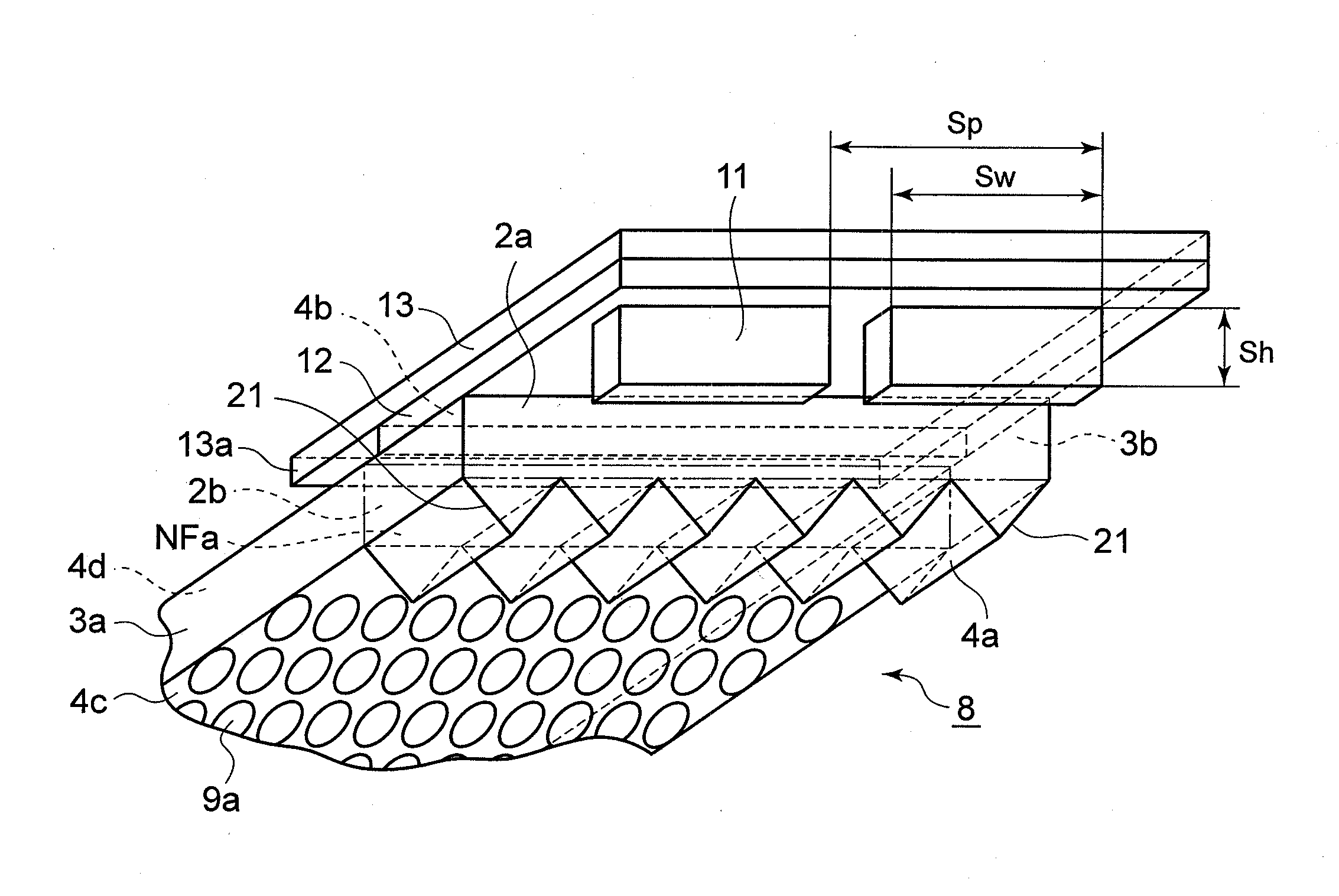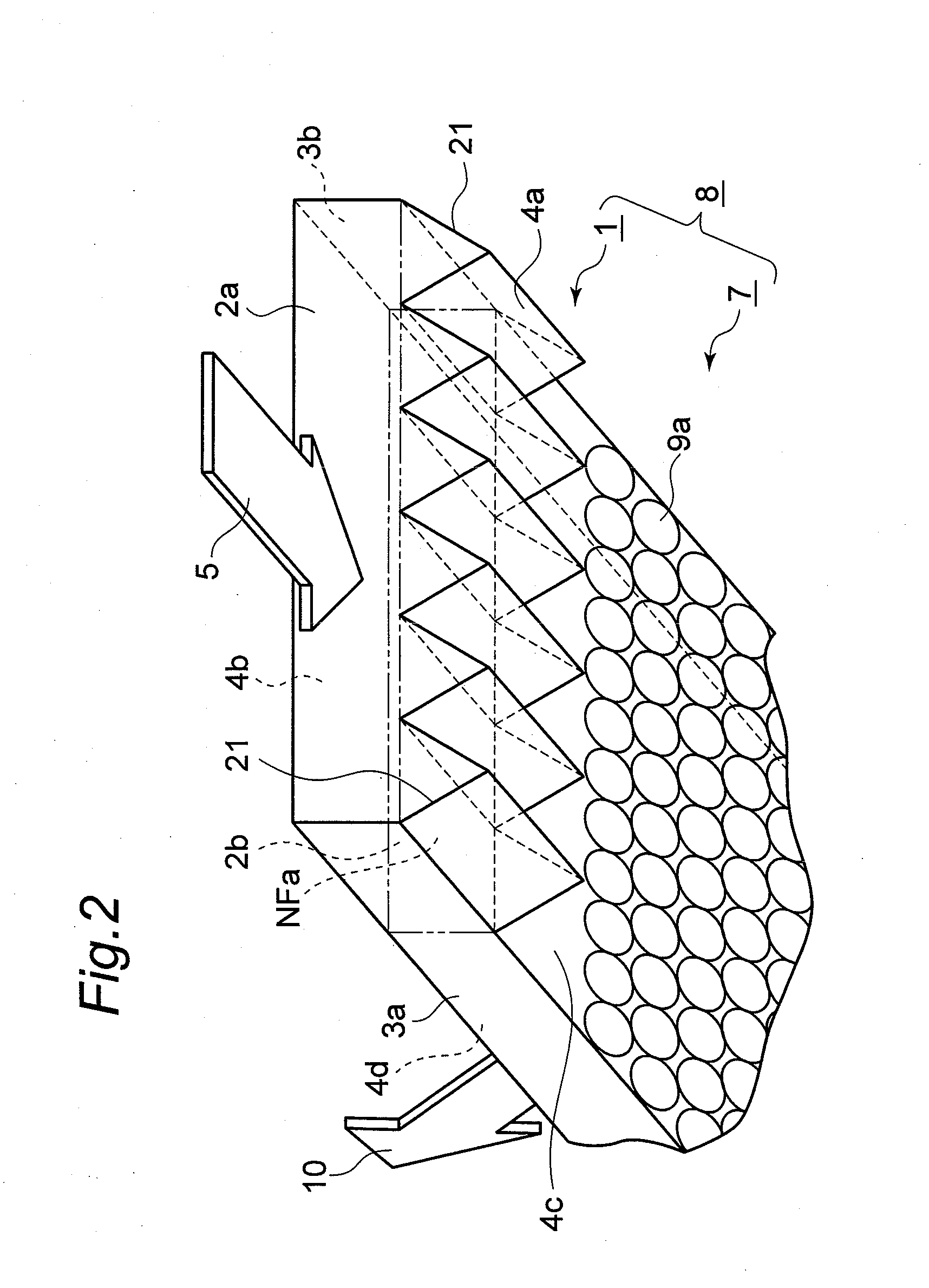Light guide plate and display device using the same
a technology of light guide plate and display device, which is applied in the direction of planar/plate-like light guide, lighting and heating apparatus, instruments, etc., can solve the problems of insufficient uniformity of light flux level of plurality of light fluxes, inability to enhance light-illuminating intensity of backlight, and reduced brightness of display device, etc., to achieve low scattering of light fluxes, suppress firefly phenomenon, and widen the effect of display device effective display area
- Summary
- Abstract
- Description
- Claims
- Application Information
AI Technical Summary
Benefits of technology
Problems solved by technology
Method used
Image
Examples
first embodiment
[0022]FIG. 1 is a perspective view of a light flux unifying region 1 in a light guide plate of a first embodiment. The light guide plate of the first embodiment has a tabular shape, and has an incident surface which receives incident light and a light emitting plane which unifies the incident light and emits uniform light. The light flux unifying region 1 is provided between the incident surface and the light emitting region. Only the light flux unifying region 1 is shown in FIG. 1. A plurality of parallel grooves, providing a zigzag surface, are formed on one plane of the light flux unifying region 1. This plane is preferably a plane opposite to the light emitting plane. Similar grooves may be provided on the other plane, if necessary. The grooves extend from the incident surface and the direction in which the grooves extend is along an optical axis of the incident light. Therefore, the direction of the grooves is almost perpendicular to the incident surface. The shape of the groov...
second embodiment
[0054]In the second embodiment, points differing from the first embodiment are principally described. Since other constitutions, actions and effects except these points are similar to those of the first embodiment, descriptions thereof will not be repeated.
[0055]FIG. 5 is a perspective view of a light flux unifying region 1A in a light guide plate of the second embodiment. An incident surface 2aA of the light flux unifying region 1A has inclined planes saw tooth-shaped and inclined in alternating one direction and the other direction. The incident surface 2aA is disposed in the vicinity of a virtual plane NFb. The virtual plane NFb is disposed perpendicular to the virtual plane NFa, the side 3a, side 3b and the surface 4b, respectively, across the boundary lines N1, N5, N6 and N7.
[0056]As shown in FIG. 5, a boundary line 21A between the incident surface 2aA and the virtual plane NFa forms a saw tooth shape in which a pitch Pb of the saw teeth is longer than a width Lb of the saw too...
third embodiment
[0059]In the third embodiment, points differing from the first and the second embodiments are principally described. Since other constitutions, actions and effects except these points are similar to those of the first and the second embodiments, descriptions thereof will not be repeated.
[0060]FIG. 7 is a schematic view showing a shape of a curve, having an inflection point, in a light guide plate of the third embodiment. In the light guide plate of the third embodiment, the light flux unifying surface 4a has a boundary line 21B in place of the boundary line 21. The boundary line 21B forms a shape in which a combination of two kinds of curved lines having an inflection point appears repeatedly. One kind of the curved lines has a tangent line 22a at the inflection point, and the other kind of the curved lines has a tangent line 22b at the inflection point. The tangent line 22a forms an angle Adg1 with the boundary line N1 and the tangent line 22b forms an angle Bdg1 with the boundary ...
PUM
 Login to View More
Login to View More Abstract
Description
Claims
Application Information
 Login to View More
Login to View More - R&D
- Intellectual Property
- Life Sciences
- Materials
- Tech Scout
- Unparalleled Data Quality
- Higher Quality Content
- 60% Fewer Hallucinations
Browse by: Latest US Patents, China's latest patents, Technical Efficacy Thesaurus, Application Domain, Technology Topic, Popular Technical Reports.
© 2025 PatSnap. All rights reserved.Legal|Privacy policy|Modern Slavery Act Transparency Statement|Sitemap|About US| Contact US: help@patsnap.com



